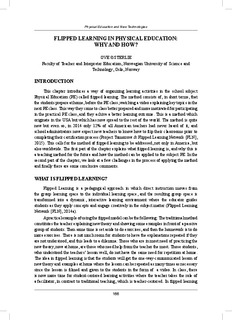| dc.description.abstract | This chapter introduces a way of organizing learning activities in the school subject
Physical Education (PE) called flipped learning. The method consists of, in short terms, that
the students prepare at home, before the PE class, watching a video explaining key topics in the
next PE class. This way they come to class better prepared and more motivated for participating
in the practical PE class, and they achive a better learning outcome. This is a method which
originate in the USA but which has now spread to the rest of the world. The method is quite
new but even so, in 2014 only 12% of all American teachers had never heard of it; and
school administrators now expect new teachers to know how to flip their classrooms prior to
completing their certification process (Project Tomorrow & Flipped Learning Network [FLN],
2015). This calls for the method of flipped learning to be addressed, not only in America, but
also worldwide. The first part of the chapter explains what flipped learning is, and why this is
a teaching method for the future and how the method can be applied to the subject PE. In the
second part of the chapter, we look at a few challenges in the process of applying the method
and finally there are some conclusive comments. | nb_NO |
